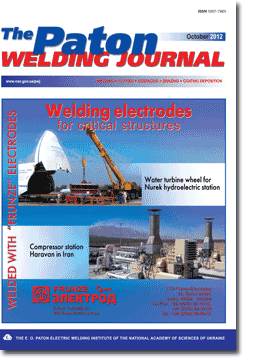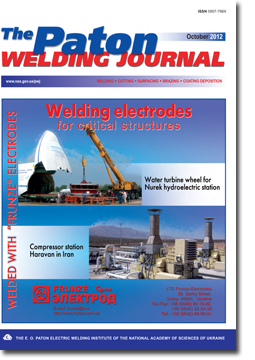| 2012 №10 (08) | 2012 №10 (01) |

The Paton Welding Journal, 2012, #10, 49-54 pages
CONTROL OF FORMATION OF WELDED JOINTS IN ESW (Review)
I.V. Protokovilov and V.B. Porokhonko
E.O. Paton Electric Welding Institute, NASU, Kiev, Ukraine
Abstract
Some technological approaches and methods for affecting the process of electroslag welding (ESW), aimed at optimisation of structure of the weld and HAZ metals, are considered. It is shown that the external magnetic fields providing the force effect on the weld pool by a contactless method are an efficient tool to control solidification of metal in ESW. The most effective schemes of electromagnetic control of the ESW process, ensuring homogenisation and refining of structure of the weld metal, are studied.
Keywords: electroslag welding, solidification, macrostructure, weld, electromagnetic effect, hydrodynamics, magnetic field
Received: ??.??.??
Published: 28.10.12
References
1. (1980) Electroslag welding and cladding. Ed. by B.E. Paton. Moscow: Mashinostroenie.
2. Yushchenko, K.A., Lychko, I.I., Sushchuk-Slyusarenko, I.I. (1999) Effective techniques of electroslag welding and prospects for their application in welding production. In: Welding and Surf. Rev., Vol.2, Pt 2. Amsterdam: Harwood Acad. Publ.
3. Medovar, B.I., Tsykulenko, A.K., Bogachenko, A.G. et al. (1982) Electroslag technology abroad. Kiev: Naukova Dumka.
4. Eregin, L.P. (1999) ESW with consumable nozzle. Avtomatich. Svarka, 9, 44-46.
5. Semyonov, V.M. (2010) Increase in efficiency of production of large-tonnage structures by electroslag welding method: Syn. of Thesis for Dr. of Techn. Sci. Degree. Mariupol.
6. Paton, B.E., Dudko, D.A., Palti, A.M. et al. (1999) Electroslag welding (prospects of development). Avtomatich. Svarka, 9, 4-6.
7. Ivochkin, I.I. (1972) Electroslag welding using powdered filler metal. Svarochn. Proizvodstvo, 5, 43-45.
8. Semyonov, V.M., Gulida, V.P., Yakovleva, L.I. (1987) Electroslag welding of 09G2S steel parts 60-140 mm thick by using auxiliary filler wire. Ibid., 2, 15-18.
9. Kuzmak, E.M., Khakimov, A.N., Efimenko, L.A. et al. (1975) Application of electroslag welding with zonal control of thermal cycles for production of petrochemical equipment of 16GS and 09G2S steels. Ibid., 6, 16-19.
10. Sushchuk-Slyusarenko, I.I., Lychko, I.I. (1974) Technique of electroslag welding. Kiev: Naukova Dumka.
11. Sushchuk-Slyusarenko, I.I., Bryzhenko, F.G., Shabalin, N.N. et al. (1975) Electroslag welding with increased electrode stick-out. Avtomatich. Svarka, 5, 71-72.
12. Dudko, D.A., Kuzmenko, A.B. (1997) Vibro-pulse action on solidified weld pool metal in ESW. Ibid., 11, 32-36.
13. Kompan, Ya.Yu., Shcherbinin, E.V. (1989) Electroslag welding and melting with controlled MHD-processes. Moscow: Mashinostroenie.
14. Kuznetsov, V.D., Kozakov, N.K., Shalda, L.M. (1987) Magnetic control of electroslag process. Kiev: Vyshcha Shkola.
15. Krishna, K. (1996) Narrow-gap improved electroslag welding of bridges. Welding in the World, 38(11), 325-335.
16. (2000) FHWA Memorandum: Narrow-gap electroslag welding for bridges. March 20.
17. Bondarenko, O.P., Moskalenko, A.A., Tyukalov, V.G. et al. (1999) High-speed ESW of plate metal without normalizing of welded joints. Avtomatich. Svarka, 9, 28-31.
18. Protokovilov, I.V., Kompan, Ya.Yu. (2010) Electroslag technologies of melting and welding of titanium alloys with controlled hydrodynamic processes. In: Proc. of Int. Conf. on Titanium in CIS (16-19 May, Ekaterinburg, Russia), 154-157.
Suggested Citation
I.V. Protokovilov and V.B. Porokhonko (2012) CONTROL OF FORMATION OF WELDED JOINTS IN ESW (Review). The Paton Welding J., 10, 49-54.The cost of subscription/purchase order journals or individual articles
| Journal/Currency | Annual Set | 1 issue printed |
1 issue |
one article |
| TPWJ/USD | 384 $ | 32 $ | 26 $ | 13 $ |
| TPWJ/EUR | 348 € | 29 € | 24 € | 12 € |
| TPWJ/UAH | 7200 UAH | 600 UAH | 600 UAH | 280 UAH |
| AS/UAH | 1800 UAH | 300 UAH | 300 UAH | 150 UAH |
| AS/USD | 192 $ | 32 $ | 26 $ | 13 $ |
| AS/EUR | 180 € | 30 € | 25 € | 12 € |
| SEM/UAH | 1200 UAH | 300 UAH | 300 UAH | 150 UAH |
| SEM/USD | 128 $ | 32 $ | 26 $ | 13 $ |
| SEM/EUR | 120 € | 30 € | 25 € | 12 € |
| TDNK/UAH | 1200 UAH | 300 UAH | 300 UAH | 150 UAH |
| TDNK/USD | 128 $ | 32 $ | 26 $ | 13 $ |
| TDNK/EUR | 120 € | 30 € | 25 € | 15 € |
AS = «Automatic Welding» - 6 issues per year;
TPWJ = «PATON WELDING JOURNAL» - 12 issues per year;
SEM = «Electrometallurgy Today» - 4 issues per year;
TDNK = «Technical Diagnostics and Non-Destructive Testing» - 4 issues per year.


